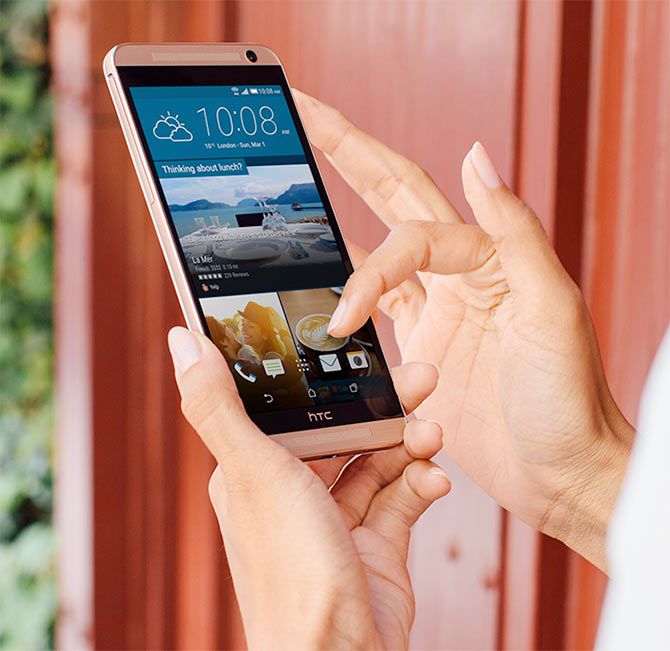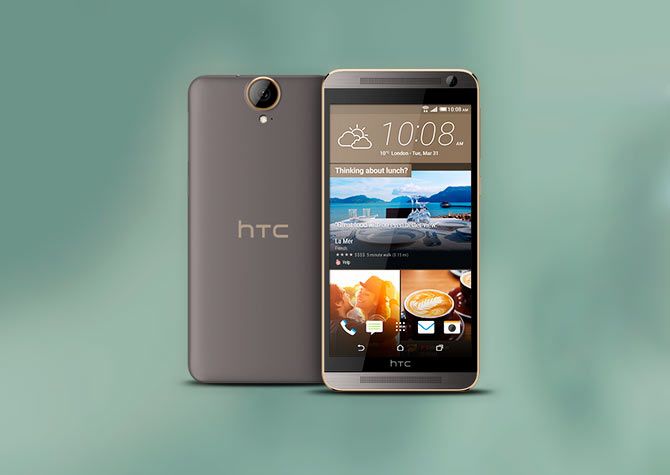HTC is ready with another addition to its already impressive line up. The all new entrant happens to be HTC One E9+, a phablet.
And for those who won't mind looking at other brands for Rs 38,000, there is the Google Nexus 6 as well as the Samsung Galaxy Note 4 which are better options in the same price range, says Himanshu Juneja.

Starting right from the impressive built, to solid innards and a good camera, the phone looks to be having all the components to make up for an undercover flagship level device. In fact, the phone boasts of a resume impressive enough to lock horns with HTC's reigning flagship device.
Let us take a close look at what the E9 plus does so good that it actually is stealing the limelight away from its superior cousin.
Built and design
Measuring 6.16 x 3.01 x 0.3 inches in dimensions, and weighing 150 gms, the phablet sports a unibody, rendered in a soft matte finish polycarbonate material. A chrome outline at front lends a good aesthetic touch.
Also at the front, the familiar Boomsound stereo speaker set up greets the users.
Starting from the top, one finds the 3.5 mm audio jack. The absence of an IR blaster might disappoint some. The phone has on its right side the volume rocker and the power button. The left side plays host to a big flap which covers the slot for microSD card as well as two slots for the nano SIM cards as well. The micro USB port is located at the bottom.
Flipping the phone over, one finds the camera lens which has a huge footprint. The sheer size seems to be there pretty much to make the phone stand out in the crowd since the actual camera lens inside is pretty much the regular size.
The phone is not small or regular by any means, and the term phablet comes to the rescue for its tall design. The side bezel itself is decently sized, but allows the handler to establish a good grip. The missing curved back design doesn't go unnoticed and the phones looks to be more of a Desire series member than from the HTC 'One' stable.
The phone is overall sturdy and despite lacking the curved back, it comes across as a well built device.
Display

HTC has supplied the E9+ with a pretty solid looking display unit. Measuring 5.5-inch diagonally and carrying a resolution 1440 x 2560 pixels means it has a superb pixel density of 534 ppi.
The colours are accurate and the saturation level looks optimum. The display has good contrast, viewing angles and is bright enough for the user to view the content under direct sunlight. The text appeared sharp and crisp, making the display one of the strong selling point for the display.
Hardware
The phone comes with Mediatek MT6795M chipset, which consists of an Octa core processor clocked at 2 GHz. Paired along with PowerVR G6200 GPU, this configuration comes along with 3 GB RAM.
As for the onboard storage, the phone has been provided with 32GB, out of which about 22 GB is available to the user. This can of course be increased up to 128 GB via microSD card.
While it was great to see ample amount of RAM available, the choice of GPU was baffling. The True octa core CPU is quite capable, but the GPU on the other hands caters to pretty lowly standards and is about an entry level entity. The combination really is perplexing.
Connectivity
A dual SIM device, the HTC One E9+ is LTE enabled and will support the Indian bands for 4G connectivity. Out of the two SIM cards, only one can be connected to 4G/3G network, while the other will have to make do with 2G network only.
Coming with features like microUSB v3.0 (MHL 2 TV-out), along with apt-X and A2DP is a big bonus and should bring smiles on the face of the owner. Usual connectivity options like Wi-Fi (dual band), Wi-Fi direct, DLNA, Bluetooth 4.1 are present as well.
For GPS assistance, the phone boasts of AGPS and GLONASS.
Software

The One E9+ comes with Android Lollipop (5.0.2) operating system, with HTC's popular Sense (ver 7) on top.
One is greeted with a lockscreen comprising of the weather as well as time display, along with four shortcuts. In case there has been a missed call or some messages delivered, the notification is displayed duly as well. The unlocking can be achieved by either a double tap or an upward swipe.
The left most screen is the regular BlinkFeed, which displays the content from news as well as the social media websites. It can of course be turned off if the user so desires. A new bit of addition here is the MealTime, which passes on suggestions to the user about the eating outlets users might opt for based on user's eating preference.
Theme support is included for the users to make the user experience rich and customised. A dedicated theme store allows the users to choose and grab from numerous options.
Sense Home widget is present here as well. Comprising of six shortcuts and two smart folders of recent documents and recommended apps. The latter can be removed, but not the six shortcuts. These are in turn suggested by HTC Sense itself, based on user's frequently used software.
Screen pinning is another useful feature which allows users to pin their frequently used apps to make them omnipresent at all times.
Zoodle app is a thoughtful addition which allows one to define the apps to be allowed access to while the device is handled by kids. The kid profile can be established complete with birth date and photos. One can even download selected data from within the app.
HTC sense's Car mode screen can be made to pop up as soon as the user connects the device with the vehicle's Bluetooth. The screen carries various options for instant access.
Overall, the OS department wins the brownie points again. Thanks to the rich experience, HTC's Sense skin has rightfully retained the crown of the most polished OS around.
Performance
The true octa core nature of the CPU ensures that the device has the raw power under the hood to accomplish the tasks despite the under clocking. The number of apps opened is handled nicely by the ample RAM and CPU takes care of the tasks to make the experience smooth. This includes the HD gaming as well as the HD media files as well.
However, a below par GPU spoils the party as the graphics take a hit. The poor pixel shader performance means texture of the objects falls short of expectations and finer details go missing, impeding the overall fidelity. This is certainly not to be expected for a phone which is costing around Rs 38,000.
A better GPU would have meant a more deservingly rich experience and this choice here really is something which only HTC may explain. Any worse and HTC could have well been accused of putting in a GPU just to make the numbers.
The BoomSound speakers perform with results expected out of them: volume and quality. Tremendously enhance the media viewing as well as gaming and music experience, the bookshelf speaker like performance has set standards for the industry.
Camera

The phone is equipped with 20 MP rear camera along with LED flash. As for the front camera, HTC places the 4 MP Ultra Pixel module. It is good to see the phone carrying the same 20 MP Camera as HTC One M9 Plus does.
The app seems rich enough and provides for good number of modes like Panorama, Bokeh, Photo Booth and split capture. The Manual mode provides access to parameters like ISO, exposure, white balance etc. The dynamic range isn't that impressive.
Clicking away the picture, one finds the camera to be capable of capturing good details, but the presence of noise is also felt unmistakably. The colours are accurate, but there is a bit of yellowish hue to the stills, and lack of image stabilisation mechanism is a sore point. The camera has issues with macro mode and it takes some task in getting a focus lock on desired points.
The detailed pics are a plus points and results are more than acceptable, but issues do prevail. Night time photography witnesses increase in the noise levels.
Somewhat similar story is observed with videography as well. Results show good level of details and good color reproduction, but the yellow tinge remains. The phone is capable of 4k as well as 1080p recording.
The front camera is a wide angled variant and this is thoughtful. The results here are with good amount of details and are sure to impress the selfie enthusiasts.
Battery
HTC provided the E9+ with a Li-Po battery pack of 2,800mAh. The non-removable nature of the battery may not please too many, but to offer some relief, the battery does perform nicely.
Despite having to power up a phablet screen, the battery lasts for a day on a normal to heavy usage pattern. For whatever it is worth, the underclocking of the CPU somewhat contributed to the cause here.
Although it would have been ideal if HTC had gone with a 3000 mAh power pack, but with a claimed standby time of about 617 hours while being on a 3G network, the battery pack does its job in a decent fashion.
Verdict

HTC has come up with a solid device which impresses on all accounts. A phone with impressive screen, classy OS experience, and a capable camera. It is indeed a worthy recommendation ahead of HTC's current flagship as it ticks all the right boxes and yet is lighter on the pocket. However, that is as far as the recommendation goes for this phone.
HTC, for some reason, has been bringing out devices which have been modest with one or two essential ingredients. With HTC One E9+, it is lacking the metal unibody as well as a befitting and an all important GPU unit. For a device costing a shade under Rs 38,000, this is criminal.
Camera performance could have been better as well.
The E9 plus is a great upgrade from the HTC One E8 and is a worthy recommendation if one is looking to purchase solely from HTC's stable. For those who won't mind looking at other brands, there is the Google Nexus 6 as well as the Samsung Galaxy Note 4 which are better options in the same price range.










